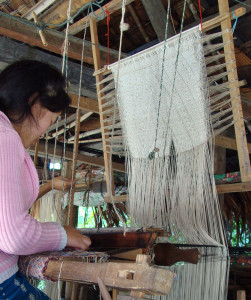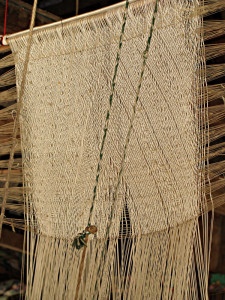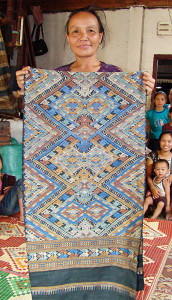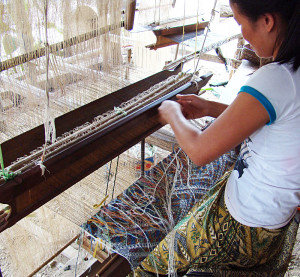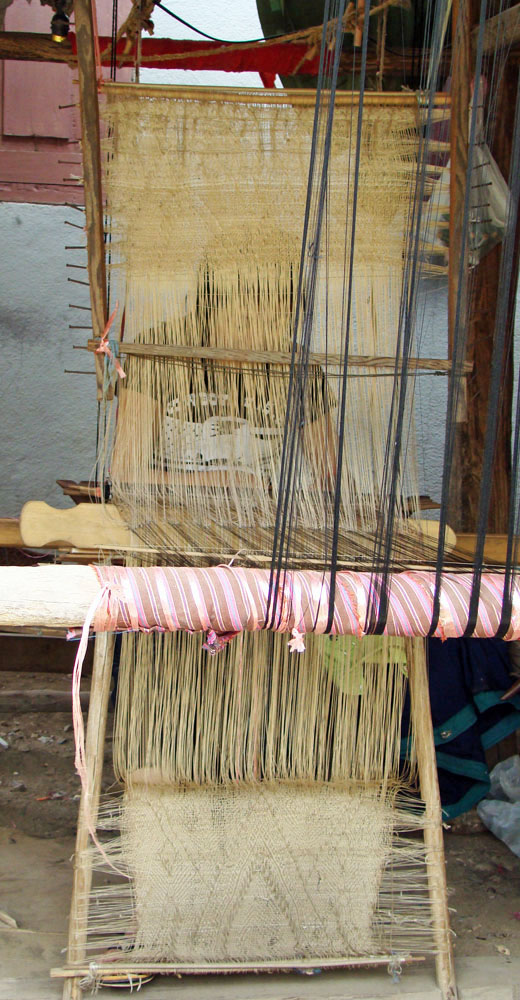The Intricacy of Koh (Discontinuous Supplementary Weft Pattern Weaving)
Souk and other weavers who create the intricate ceremonial blanket, shaman and healing cloths utilize a complex technique of loom weaving called discontinuous supplementary weft (or Koh, in Lao). Once the warp threads (the length) are strung, Koh requires that the artist, while weaving the weft threads (the width), hand-picks different colored threads and loops these supplemental threads onto selected warp threads to create the desired designs. These textiles are woven with the backside of the fabric facing up on the loom so the weaver has access to looping the supplemental threads neatly. However, the weaver cannot see the emerging finished pattern on the bottom side and must, as Patricia Cheesman writes (Lao-Tai Textiles, 2004), ”work in the abstract since nothing is written down… (and) hold the image of the design in her mind.”
To assist the weaver with complex designs, long shafts made of wood can be placed within the vertical heddles that create each row’s pattern. To set this up, the heddles (vertical threads that intersect with the warp threads) are first positioned in the warp by looping strings around each warp thread and passing about a half meter above and below the textile. Pattern sticks are then placed into the verticalheddles, instead of the warp, with each stick (and there may be hundreds of them) lifting the selected warp threads according to the desired pattern. The weaver brings the heddles separated by each pattern stick in turn towards herself, lifts the selected warp threads, and places a wooden sword into the shed (the selected warp threads) to hold it open while she hand-picks that one row of what may be dozens of supplemental threads. She then removes the sword and weaves a tabby shed (a row of plain weave) to hold the new threads in place. The pattern stick is then placed into the vertical heddles below the textile in the same order which stores the pattern; this allows the weaver, once a design is complete, to start the process in reverse creating the mirror image of the original pattern (thus, each complex design image is woven with its reflection). Sometimes the designs are so complex, using over 1000 pattern sticks, that string is used instead of sticks to take up less space on the loom – this is the manner in which most of the textiles we purchase in this region are made.
Koh is an amazing process to watch. The weaver’s fingers dance over the threads, moving shuttles, looping threads, and lifting warp; a slip of the finger or the mind, or a single dropped thread can create glaring errors. Precision, consistency and accuracy are required with every move, from designing the pattern to raising, spinning and dyeing the silk, to completing months of weaving.
For centuries, these Koh textiles have been used for ceremonial purposes by shaman as well as ordinary villagers. These traditional textiles have been created to symbolize, access and affect the world of spirits and ancestors, and are used for healing ceremonies, planting and harvest rituals, protective rituals for travelers and newborns, and at weddings and funerals. These devoted dyers and weavers, their art and traditions, have been central to their cultural memory.

